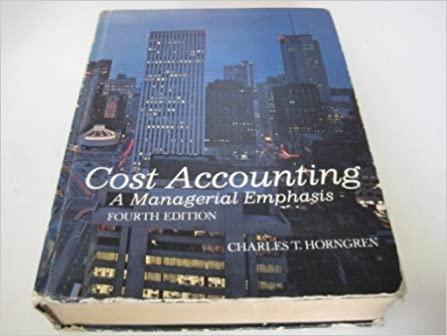Joint and By-Products, Process Further (CMA) Gossett Chemical Company uses comprehensive annual profit planning procedures to evaluate
Question:
Joint and By-Products, Process Further (CMA) Gossett Chemical Company uses comprehensive annual profit planning procedures to evaluate pricing policies, to finalize production decisions, and to estimate unit costs for its various products. One particular product group involves two joint products and two by-products. This product group is separately analyzed each year to establish appropriate production and marketing policies.
The two joint products-ALCHEM-X and CHEM-P—emerge at the end of processing in Department 20. Both chemicals can be sold at this split-off point-ALCHEM-X for $2.50 per unit and CHEM-P for $3.00 per unit. Byproduct BY-D20 also emerges at the split-off point in Department 20 and is salable without further processing for $.50 per unit. Unit costs of preparing this by-product for market are $.03 for freight and $.12 for packaging.
CHEM.-P is sold without further processing, but ALCHEM-X is transferred to Department 22 for additional processing into a refined chemical labeled as ALCHEM-XF. No additional raw materials are added in Department 22. ALCHEM-XF is sold for $5.00 per unit. By-product BY-D22 is created by the additional processing in Department 22, and it can be sold for
$.70 per unit. Unit marketing costs for BY-D22 are $.05 for freight and $.15 for packaging.
Gossett Chemical Company accounts for by-product production by crediting the net realizable value of by-products produced to production costs of the main products. The net realizable-value method is used to allocate net joint production costs for inventory valuation purposes.
A portion of the 19_5 prdéfit plan established in September 19_4 is presented here.
Shortly after this budget was compiled, the company learned that a chemical that would compete with ALGHEM-XF was to be introduced. The marketing department estimated that this would require a permanent price reduction to $3.50 a unit for the ALCHEM-XF to be sold in present quantities. Gossett must now reevaluate the decision to process ALCHEM-X further.
The market for ALCHEM-X will not be affected by the introduction of this new chemical. Consequently, the quantities of ALCHEM-X that are usually processed into ALCHEM-XF can be sold at the regular price of $2.50 per unit. The costs for marketing ALCHEM-X are estimated to be $105,000.
If the further processing is terminated, Department 22 will be dismantled and all costs except equipment depreciation, $18,400; supervisory salaries, $21,200;
and general overhead, $35,200 will be eliminated.
UNITS OF PRODUCTION CHEM-P ALCHEM-XF Estimated sales 400,000 210,000 Planned inventory change — 8,000 —6,000 Required production 392,000 204,000 Minimum production based upon joint output ratio 392,000 210,000 By-product output BY-D20 90,000 BY-D22 60,000 COSTS Budgeted Production Costs Department 20 Department 22 Raw material $160,000 -
Costs transferred from 20* = $225,000 Hourly direct labor 170,000 120,000 Variable overhead 180,000 140,800 Fixed overhead 247,500 188,000 $757,500 $673,800 Budgeted Marketing Costs CHEM-P ALCHEM-XF $196,000 $105,000 “The cost transferred to Department 22 is calculated as follows:
SALES VALUE OF OUTPUT ALCHEM-X (210,000 x $2.50) $ 525,000 31%
CHEM-P (392,000 X $3.00) 1,176,000 69%
$1,701,000 100%
Department 20 costs $ 757,500 less by-product (90,000 x $.35) 31,500 Net costs $ 726,000 ALCHEM-X 31% $ 225,000 or $1.07 per unit CHEM-P 69 501,000 or $1.28 per unit Allocated net costs 100% $726,000 Should Gossett sell ALCHEM-X at the split-off point or continue to process it further in Department 22? Prepare a schedule of relevant costs and revenues to support your answer.
During discussions of the possible dropping of ALCHEM-XF one person notes that the manufacturing margin for ALCHEM-X would be 57.2 percent [(2.50 — 1.07)/2.50] and 57.3 percent for CHEM-P. The normal markup for products sold in the market with ALCHEM-X is 72 percent. For the CHEM-P portion of the line the markup is 47 percent. He argues that the company’s unit costs must be incorrect, because the margins differ from the typical rates.
Briefly explain why Gossett’s rates for the two products are almost identical when “normal” rates are not.
Step by Step Answer:






